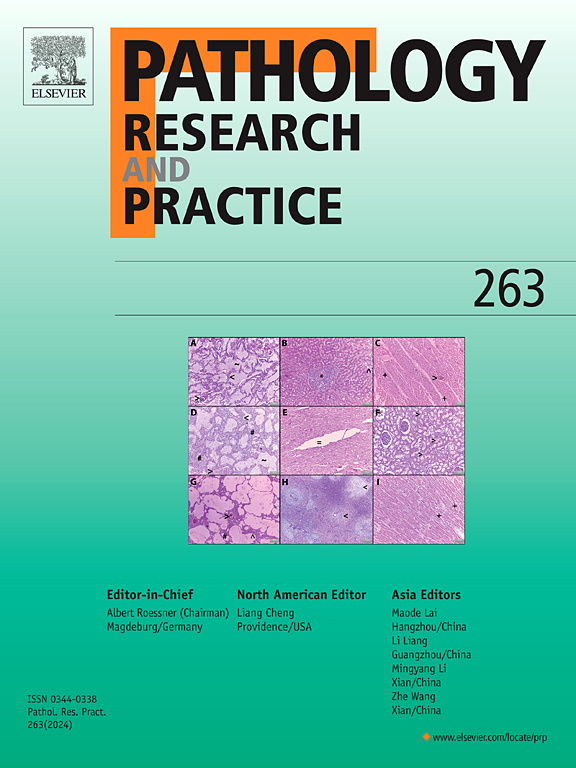YY1-VDR轴介导的自噬减缓了椎间盘退变的进展
IF 3.2
4区 医学
Q2 PATHOLOGY
引用次数: 0
摘要
老龄化伴随着椎间盘退变(IVDD),导致生活质量下降和显著的社会经济负担。本研究旨在探讨转录因子阴阳1 (YY1)在IVDD中的作用,并阐明其潜在机制。方法采用转录组测序技术筛选早期和晚期IVDD患者髓核(NP)组织中的差异表达基因。小鼠采用IVDD模型,用H2O2和慢病毒处理NP细胞。观察小鼠和h2o2处理的NP细胞的氧化应激和自噬。预测与YY1表达密切相关的基因,并通过ChIP和双荧光素酶实验验证其结合关系。设计体外自噬激动剂雷帕霉素抢救实验。最后,探讨了YY1下调的上游机制。结果晚期IVDD患者NP组织中syyi表达降低,过表达YY1的小鼠氧化应激和细胞凋亡明显降低,自噬相关蛋白水平升高。YY1过表达可降低h2o2处理的NP细胞的凋亡和ROS水平,降低凋亡标志物的表达,增加自噬。YY1与维生素D3受体(VDR)启动子结合,刺激VDR转录。雷帕霉素处理的NP细胞LC3表达增加,ROS水平降低,凋亡增加。YY1甲基化随IVDD加重而增加。结论YY1激活VDR可改善NP细胞氧化应激,并通过促进自噬来减少NP细胞凋亡。这一过程可能成为治疗IVDD的一个有希望的治疗靶点。本文章由计算机程序翻译,如有差异,请以英文原文为准。
YY1-VDR axis-mediated autophagy slows the progression of intervertebral disc degeneration
Background
Aging is accompanied by degeneration of the intervertebral discs (IVDD), which leads to a poor quality of life and a significant socioeconomic burden. The present study aimed to explore the effect of transcription factor Yin and Yang 1 (YY1) on IVDD and to elucidate the potential underlying mechanism.
Methods
Differentially expressed genes in nucleus pulposus (NP) tissues from patients with early or advanced IVDD were screened out using transcriptome sequencing. Mice were subjected to IVDD modeling, and NP cells were treated with H2O2 and lentivirus. The oxidative stress and autophagy were assessed in mice and H2O2-treated NP cells. Genes closely associated with YY1 expression were predicted, and ChIP and dual-luciferase experiments were conducted to authenticate their binding relationship. Autophagy agonist rapamycin rescue experiments were designed in vitro. Finally, the upstream mechanism for YY1 downregulation was examined.
Results
YYI expression was reduced in NP tissues of patients with advanced IVDD, and mice overexpressing YY1 showed significantly decreased oxidative stress and apoptosis, and increased levels of autophagy-related proteins. Overexpression of YY1 reduced the apoptosis and ROS levels, decreased the expression of apoptosis markers, and increased the autophagy in H2O2-treated NP cells. YY1 bound to the vitamin D3 receptor (VDR) promoter and stimulated the VDR transcription. Rapamycin-treated NP cells showed increased expression of LC3, decreased ROS levels, and apoptosis. YY1 methylation increased with worsening IVDD.
Conclusions
Activation of the VDR by YY1 improves oxidative stress and reduces NP cell apoptosis by promoting autophagy. This process may serve as a promising therapeutic target for managing IVDD.
求助全文
通过发布文献求助,成功后即可免费获取论文全文。
去求助
来源期刊
CiteScore
5.00
自引率
3.60%
发文量
405
审稿时长
24 days
期刊介绍:
Pathology, Research and Practice provides accessible coverage of the most recent developments across the entire field of pathology: Reviews focus on recent progress in pathology, while Comments look at interesting current problems and at hypotheses for future developments in pathology. Original Papers present novel findings on all aspects of general, anatomic and molecular pathology. Rapid Communications inform readers on preliminary findings that may be relevant for further studies and need to be communicated quickly. Teaching Cases look at new aspects or special diagnostic problems of diseases and at case reports relevant for the pathologist''s practice.

 求助内容:
求助内容: 应助结果提醒方式:
应助结果提醒方式:


